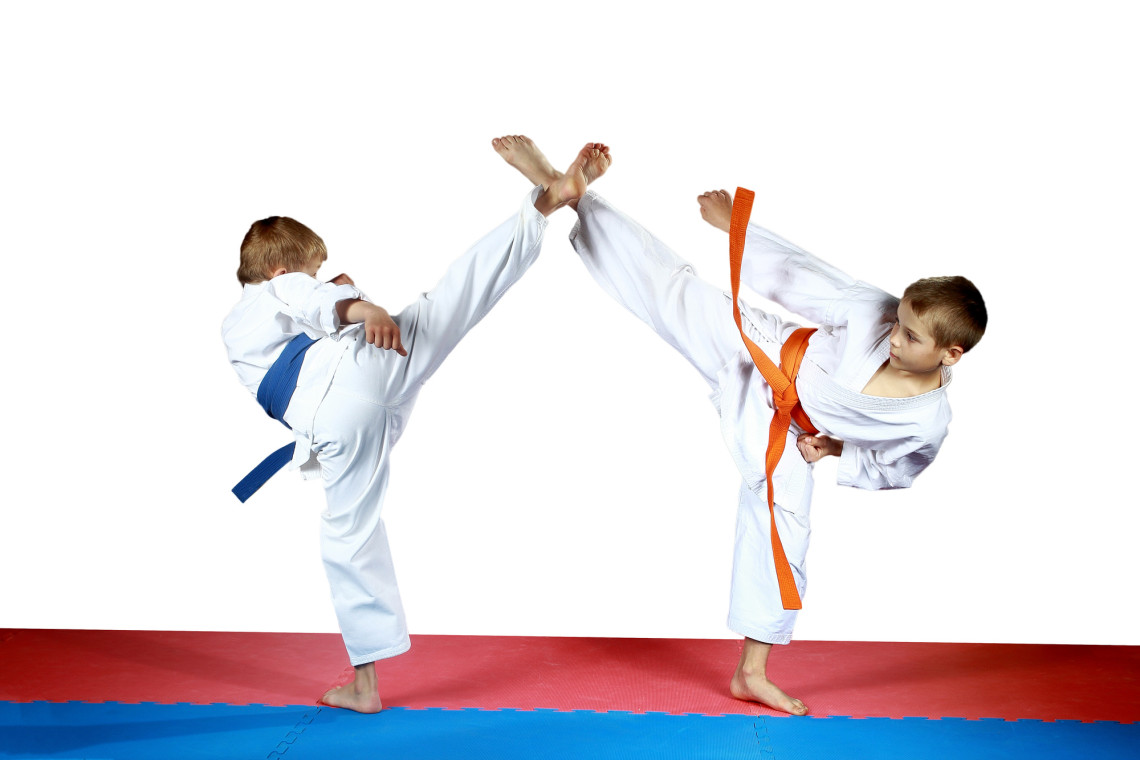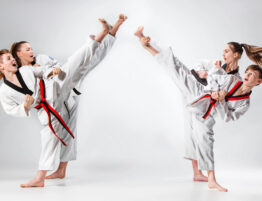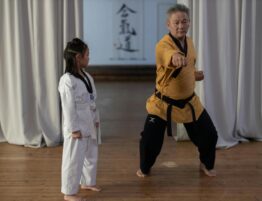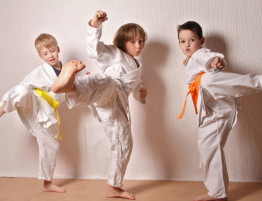
If you’re like many parents, you’re considering an after-school activity for your kids. And you’ve probably heard raving reviews from other parents on the benefits of martial arts.
But when it comes time to enroll your child, you’re completely stumped on the difference between karate and taekwondo. You think your kid would enjoy them, but you don’t know if they would enjoy one more than the other.
Here, we’re breaking down karate vs taekwondo so that you can enroll your child in the martial art that’s right for them.
Karate vs Taekwondo
But first, an honest confession: when it comes down to it, most martial arts are more similar than different.
Sure, jiu-jitsu is different from boxing, which is different from aikido and Krav Maga. But when it comes down to it, all martial arts rely on the same basic principle–using your body as a tool to defend yourself.
That said, there are subtle differences between karate and taekwondo, and different focuses between the two. Depending on what your child likes, they may prefer one over the other for that reason.
Let’s break it down.
Karate
Karate is a Japanese martial art originating in the Ryukyu Islands, specifically on Okinawa. Of course, at that time, it wasn’t called karate–it was simply called, “te”.
It came about when trade relations were established between the Ryukyu Islands and the Fujian Province in China. Families began emigrating from China to Okinawa and sharing Kenpo, a blend of Chinese and Indian fighting styles.
Three styles emerged in three distinct areas: Shuri-te, Naha-te, and Tomari-te (to be fair, the differences were minor, as the three cities are close together).
As time went on and relations continued to strengthen between Okinawa and China, the blend of traditional Okinawan fighting styles and Chinese techniques became more obvious.
The karate we know today comes from Itosu Anko, colloquially called the Grandfather of Karate. He’s credited with creating simplified kata (or forms) for less advanced students, bringing karate into the mainstream.
Characteristics
Karate, as it exists today, is referred to as a striking-style martial art. In other words, it teaches practitioners to disable opponents using kicks, punches, open-hand strikes, knees, and elbows.
However, the goal of karate is not to attack, but rather to defend oneself. Practitioners are taught to block attacks and disable opponents quickly. Many styles use weapons, though students are always taught to emphasize hand-to-hand fighting.
There are also throws, takedowns, and joint locks, though throws and takedowns are generally structured as finishing blows to end a fight.
Subtypes
There are several different subtypes of karate, each with its own distinguishing characteristics. A few commonly-practiced types include:
- Budokan
- Kenpo
- Shito-ryu
- Shorin-ryu
- Shotokan
- Uechi-ryu
- Wado-ryu
- Gojo-ryu
That said, they are all forms of karate and have more similarities than differences.
Taekwondo
We’ve taught taekwondo at Carrollwood Black Belt Academy since 1999.
Taekwondo is derived from Korean words–“tae” meaning foot, “kwon” meaning fist, and “do” meaning way. So, taekwondo literally means, “the way of the foot and fist.” But the name taekwondo didn’t exist until 1955.
Taekwondo as an art has existed in Korea for 2,300 years. Three rival kingdoms called Goguryeo, Silla, and Baekje in 57 BC to 668 trained their men in unarmed combat. Subak was the most popular, and the best known of the subak styles was called taekkyeon.
As the weakest and smallest of the three, Silla began selecting and giving specialized training to warriors called Hwarang who were a cut above the rest. Interestingly, the subak of Goguryeo was most focused on kicking and the legs, which looks more like modern taekwondo.
However, during the Joseon Dynasty, martial arts fell by the wayside in favor of Confucian scholarly practices, though it was retained in military practice. It saw an underground resurgence when the Japanese occupied Korea in the first half of the 20th century.
Once the Japanese left, martial arts schools began to open in Korea. It’s difficult to know whether these schools were based on ancient taekkyeon or Japanese karate, but they gave us modern taekwondo.
Taekwondo Today
Taekwondo today has two primary types, titled by their respective federation:
Both sides like to fight over whose taekwondo is better, and it mostly comes down to a few different forms and a difference in the number of black belt levels. That said, both sides are more similar than different.
Focus
Taekwondo is renowned for its heavy emphasis on showy kicks. It has about a dozen different types of kicks, and these are the primary fighting tool in sparring.
However, taekwondo does supplement kicks with other forms of striking, and it still places a strong focus on blocking, stances, and footwork. Like karate, it has form, or a set series of movements that students at each belt level are required to learn.
Which is Right for Your Child?
With all that in mind, which one is right for your child?
That honestly depends on which style they’re more interested in.
Karate places a stronger emphasis on hand attacks, which means the legs stay grounded so that the body can’t be thrown off balance. Kicks are primarily a backup.
Taekwondo, on the other hand, focuses predominantly on kicks, which means there are a variety of leg positions that allow the body to stay balanced while allowing the practitioner to move quickly.
Both are considered “hard” martial arts–when someone strikes you, you respond with a strike.
Children often enjoy kicking drills in which they get to learn all the flashy spinning and jumping kicks that taekwondo prizes, and since the style focuses on fast movement, sparring moves at a rapid pace. Karate kicks, on the other hand, focus on self-defense.
Both styles offer an intense full-body workout and emphasize patience, discipline, and respect–for yourself, for your opponent, for those you encounter in the world. The point of martial arts is not to seek a fight, but to know how to protect yourself if one occurs.
Martial Arts for Kids
Now that you know the differences in karate vs taekwondo, do you think you or your child are ready to give it a try?
Carrollwood Black Belt Academy offers a variety of classes from our Little Dragons program to our adult classes.
If you’re ready to give it a try, get in touch with us today!





